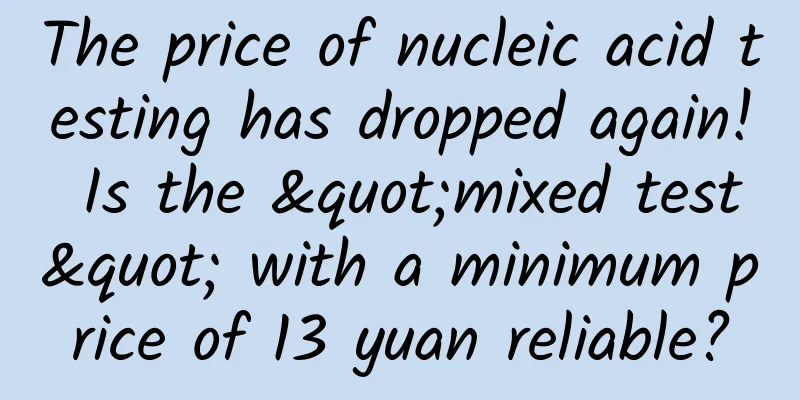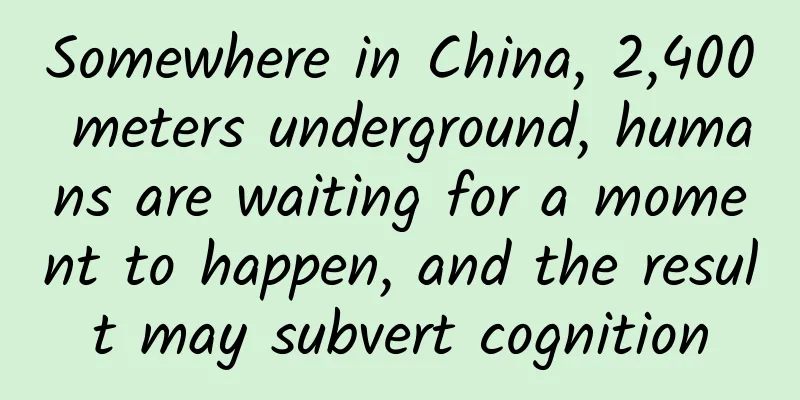The price of nucleic acid testing has dropped again! Is the "mixed test" with a minimum price of 13 yuan reliable?

|
The domestic epidemic has recurred, and the demand for nucleic acid testing has surged. Beijing announced a reduction in the price of nucleic acid testing, with the lowest price for "mixed testing" of samples being only 13 yuan. Is this testing method reliable? Let's take a look at the interpretation. Recently, sporadic cases and clustered outbreaks of COVID-19 have reappeared in many places in China, and the demand for "nucleic acid testing", a powerful tool for epidemic prevention, has also increased significantly. On October 25, Beijing announced that starting from October 26, the price of a single sample of COVID-19 nucleic acid testing in public medical institutions in the city will be reduced from 80 yuan to 58 yuan per time, and the price of a mixed test of 5 and 10 samples will be reduced from 30 yuan and 20 yuan per sample to 18 yuan and 13 yuan respectively. This is the fifth dynamic adjustment of the COVID-19 nucleic acid testing program in Beijing. Epidemic prevention and control has entered the normal stage, and strong nucleic acid testing capabilities are the key to timely containment of the epidemic. The price of nucleic acid testing continues to fall, which is good for individuals and the overall epidemic prevention and control of society. In addition to single-sample nucleic acid testing, the mixed test, which currently costs only 13 yuan, has made many people call the price "touching." What is nucleic acid “mixed testing”? The so-called "mixed testing" of nucleic acid is different from the single testing method of testing each person separately. Throat swab specimens are taken from multiple people and put together for viral nucleic acid testing. If the result is negative, no further testing is required; if the result is positive, these specimens need to be taken out and tested individually. There are two modes of "mixed testing". One is that when sampling, samples are taken from several people, such as 3 or 5 people, and then placed in the same sampling tube. This mode is also called "mixed sampling" or "mixed sampling". Beijing adopts this mode in most cases. The other is that when testing in the laboratory, samples of 3 or 5 people are mixed together in the same volume, which is also called "sample mixing". From a scientific point of view, the first "mixed sampling" mode will not affect the sensitivity of nucleic acid testing. The latter mode of mixed sample testing will have a certain impact on the sensitivity of the test, but the degree of impact is known. Xiong Zhujia, deputy chief technician of the Clinical Microbiology and Infection Laboratory of the China-Japan Friendship Hospital, introduced that the nucleic acid "mixed test" requires the collection of two swabs from each test subject. One swab is placed in the nucleic acid preservation solution of a multi-person group (generally 3-10 people) for the first test; the other swab is placed separately in the nucleic acid preservation solution for re-examination when the first test is positive. Is the “mixed testing” method reliable? The National Health Commission once responded to the reliability of the two modes of "mixed testing" on its official Weibo account. "Mixed sampling" will not affect the sensitivity of nucleic acid testing; "sample mixing" has a certain impact on the sensitivity of testing, but the extent of the impact is known. The National Health Commission pointed out that during on-site sampling, if "mixed sampling" is used, attention should be paid to orderly arrangement, such as forming a group of 5 people, each holding their own barcode, and attaching the barcode of each person to the sampling tube when sampling. This can effectively avoid the problem of possible sample confusion. During the analysis process, if the "sample mixing" mixed inspection plan is adopted, when mixing the samples of 5 people, attention should also be paid to the possible sample confusion during the sample mixing process. It should be emphasized that for the testing of high-risk groups such as symptomatic patients in fever clinics and close contacts, single sampling and single testing should still be adopted. For the screening of low-risk groups, "mixed testing" can be given priority. “Mixed testing” greatly improves detection capabilities Whenever an epidemic occurs in a certain place, a large number of people face nucleic acid testing. The nucleic acid testing procedure for the new coronavirus is complicated, and the process includes five steps: sampling, sample retention, preservation, nucleic acid extraction, and testing. It usually takes more than 4 hours from sample processing to results, and the nucleic acid extraction steps are cumbersome, time-consuming and labor-intensive, which will seriously affect the testing efficiency. In order to cope with the contradiction between time-consuming testing and huge demand, a certain proportion of nucleic acid mixed testing is adopted to put nucleic acid testing work on the fast track. For example, the daily testing capacity in Beijing used to be more than 200,000. Using this combined model, the daily testing capacity can reach more than 2 million without increasing manpower and material resources. ▲Nucleic acid sample testing is in progress (picture from the Internet) Perhaps few people know that the mixed testing method is not original during this epidemic, but is borrowed from screening whether blood donors carry HIV, hepatitis B and other nucleic acids. Its main purpose is to quickly screen the nucleic acid test results of the general population. In fact, this is not the first time that nucleic acid "mixed testing" has come to the fore during the epidemic. In the May 2020 testing of 9 million citizens in Wuhan, this testing method has been proven to be a very efficient and resource-saving way to test for COVID-19 nucleic acid. When testing capacity is limited, the orderly arrangement of mixed testing can reduce the huge sample size through mathematical methods. For example, if there are 10 million people who need to be tested, and the daily testing capacity is only 100,000, it will take 3 months to conduct individual tests. However, if "mixed testing" is conducted in groups of 10, then all 10 million people can be tested in just 10 days. To sum up, faced with the problems of a large number of people to be tested, high pressure on test kit production, and complicated steps for extracting viral nucleic acid, as well as the actual situation that the population to be tested is a large-scale general screening population with low specificity requirements, adopting a certain proportion of mixed testing can relatively save some time and energy, and achieve the result of improving the overall detection efficiency. What should we pay attention to during "mixed testing"? During the "mixed testing" process, it is imperative to strictly follow the operating specifications to avoid increasing the possibility of affecting the test results due to improper operation. The first edition of the "Beijing Novel Coronavirus Nucleic Acid Mixed Testing Sampling, Sample Processing and Result Determination Technical Guidelines" issued by Beijing Center for Disease Control and Prevention clearly stipulates special requirements from sample collection, packaging, transportation and other processes, as well as laboratory sample processing, result determination and quality control, further standardizing the nucleic acid "mixed testing" process and operating details. In nucleic acid "mixed testing", the most important step is sampling. If the sample collection is not standardized, it is likely to increase the possibility of "false negative" results due to improper operation. The Guidelines stipulate that three staff members are required to cooperate in sample collection. One staff member uses two swabs to collect samples, one swab is used as a reserve sample, and the other swab is stored in a sampling tube with the swabs of other subjects for nucleic acid testing. The other two staff members assist by holding the sampling tube and recording sample information. ▲Nucleic acid oropharyngeal swab sampling (picture from the Internet) It should be noted that a unique sample number needs to be written on both the mixed test samples and the retained samples. The purpose of this is to ensure traceability between the mixed test samples, retained samples and the tested objects. It is reported that the nucleic acid mixed test conducted in Beijing includes mixed testing of 3 people in a group and mixed testing of 5 people in a group. When mixed testing is carried out, orderly grouping can be carried out to trace the source according to the group. Once an abnormality is found, a group with a positive result can be tested again to identify the positive test subjects in the group. In order to ensure the accuracy of the test results, various measures will be taken to strengthen sampling site management and laboratory quality control. First, only professional institutions with testing qualifications can carry out testing. Second, a technical guidance and quality control working group will be set up to ensure sample quality and test quality through on-site guidance, supervision and inspection, and ensure that the test results are accurate and reliable. Mixed testing also has disadvantages Compared with "single test", the most significant advantage of "mixed test" is that it increases the speed of nucleic acid test. Moreover, the efficiency is improved while the safety is not changed. The samples are collected "one person at a time" and there will be no cross infection. On the other hand, nucleic acid mixed sample testing requires a higher sensitivity of the test kit, because the effective concentration of nucleic acid in positive samples will be diluted and reduced after multiple samples are mixed, and the purpose of the application is population screening. Therefore, ultra-high detection sensitivity is a necessary condition. The analytical sensitivity shown in the instructions of the currently approved test kits ranges from 100 copies/mL (the unit of virus concentration in the human body) to 1000 copies/mL. However, due to the destruction of nucleic acids during the nucleic acid extraction process, the analytical sensitivity of the detection systems based on the test kits in actual work is lower than the level claimed by the test kits. Moreover, the extraction of nucleic acid from mixed samples requires a unified sampling tube and sample preservation solution, which can be inactivated once and then extracted as a whole, effectively reducing the workload. However, the nucleic acid of a single sample needs to be inactivated and extracted separately, which increases the workload a lot. ▲Nucleic acid sample storage (picture from the Internet) If a positive result appears, "single test" can quickly trace the source, find the positive testee, and quickly cut off the transmission path. However, "mixed test" must be screened twice, and if there are many samples in the group, it will take more time. Ke Huixing, chief physician of the Department of Respiratory and Critical Care Medicine at Beijing Hospital, also pointed out that if the positive rate of the population to be tested is very high, such as for people in high-risk areas when the epidemic is at its peak, mixed testing is not appropriate. Instead, it will add an extra procedure and waste time for epidemic prevention and control. Therefore, when conducting "mixed testing", the detection of positive specimens should be dynamically evaluated, and the sample mixing should be appropriately increased or decreased. Xiong Zhujia pointed out that no matter what method of "mixed testing" is used, the viral load of positive samples will be diluted and reduced, and positive samples with extremely low viral counts may be missed. Therefore, it is particularly important to determine the appropriate mixed testing ratio based on the quality of the test reagents and the target population. Written by reporters Liu Daheng, Song Meng, Lai Tianying New Media Editor/Liu Daheng (Content compiled from: Beijing Science and Technology News, Beijing Evening News, etc.) Produced by: Science Central Kitchen Produced by: Beijing Science and Technology News | Science Plus Client Welcome to share to your circle of friends Source: Science Central Kitchen |
>>: NASA finally admits! Going to Mars is to search for alien life
Recommend
Bilibili Operation: How to improve community interaction?
Compared with other content platforms, Bilibili i...
When Foxconn positioned Sharp in the low-end market, the sales of tens of millions turned out to be a poison to quench thirst
After committing itself to Foxconn, Sharp seemed ...
How does iPhone 6 perform in China, Japan and South Korea?
The sales momentum of Apple iPhone 6 and 6 Plus s...
With these tools, you can easily create high-conversion landing pages even if you don’t know design or code!
The landing page is an important part of relation...
How to debug Push in one click on iOS
One of the interesting things about working in th...
How to create a high-click title and double the number of readers in 10 minutes?
In today's world of information explosion and...
DEX file format analysis
I was busy cracking the apk of China Mobile and C...
In special times, how can the retail industry operate private domain traffic well?
A sudden epidemic has brought community (WeChat g...
Nokia X2 hands-on: It's the same level as a thousand-yuan phone
With the official release of Nokia X2, what change...
Is ASO really difficult? It’s time to do the drop-down association word
Is ASO really difficult? For example, someone rec...
The super cool starry sky "palette" in the hands of the cosmic painter, you may have never seen it before
Author | Feng Ziyang Review | Dong Chenhui Editor...
"China's Sky Eye" has discovered more than 800 new pulsars and entered a period of explosive growth →
The reporter learned from the FAST Operation and ...
Get APP growth analysis report
1. Background and Purpose background Recently, I ...
Why have we done so much but the seed users just don’t buy it?
Friends who are engaged in operations may have fe...
A collection of Olympic advertising and marketing methods!
The Tokyo Olympics has been underway for ten days...









